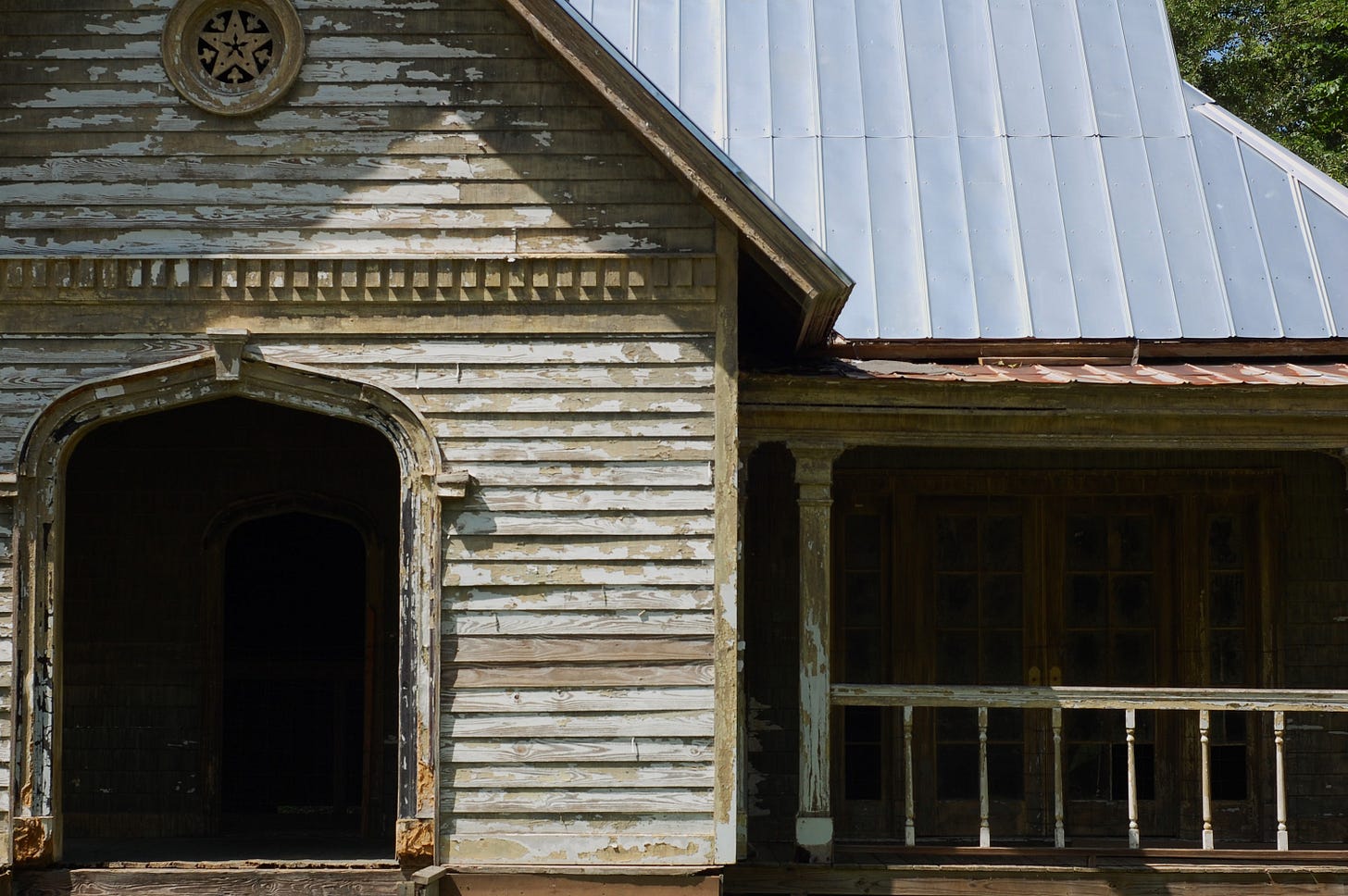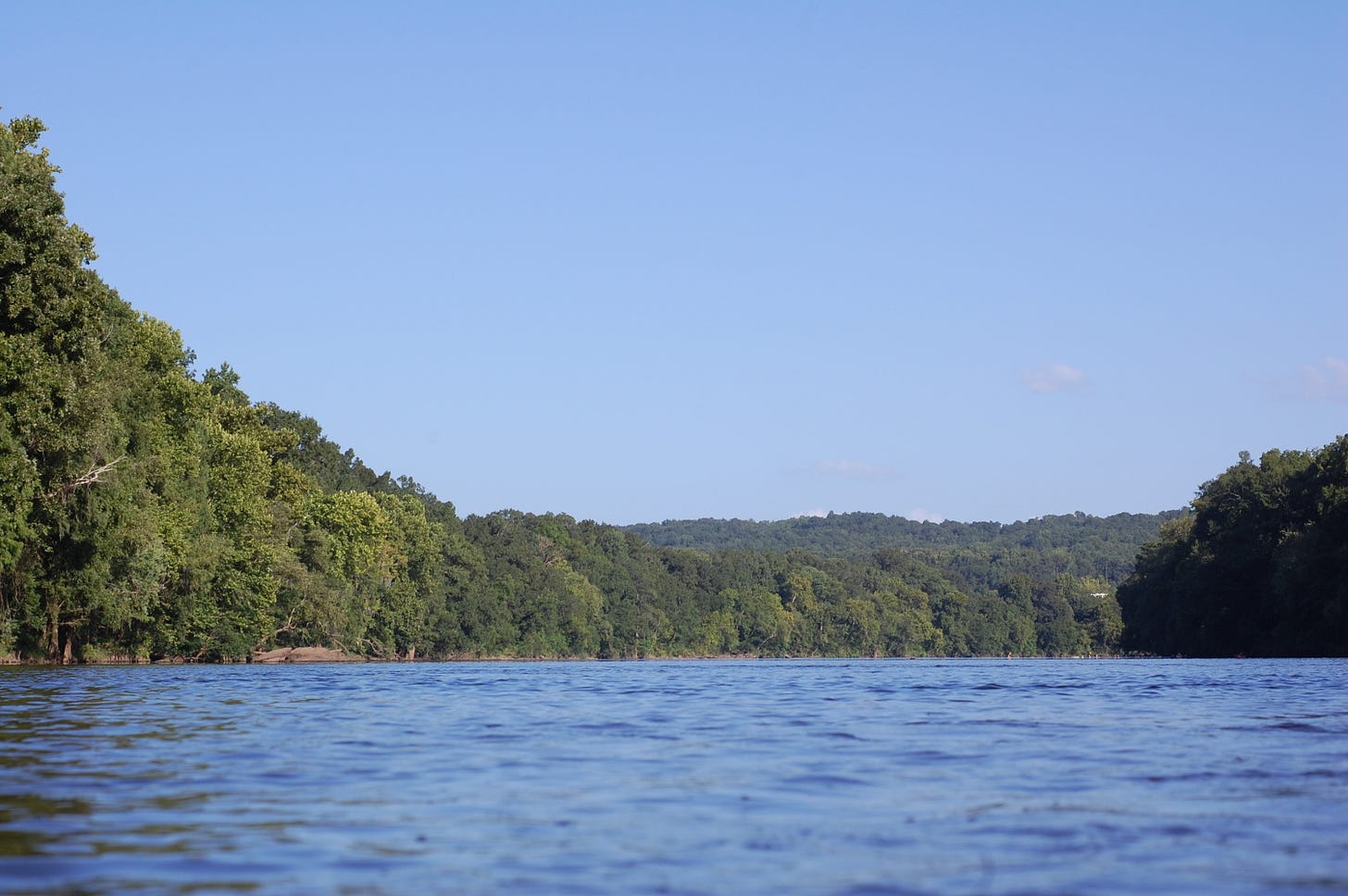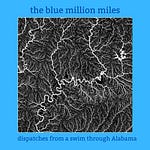To write about the waterways of Alabama is to wade through converging streams of fact and fiction, reality and lore, what’s actually true and what’s just a good story.
Let me give you an example: a few weeks ago, on an oxbow of the Alabama River just downstream from its confluence, I swam past an abandoned film set. It’s a film set that was built to appear like a town once thriving and then run down. A stretch of houses halfway completed in order to appear halfway to ruin. Facades and porches finished and then weathered; floorboards unlaid and back doors never hung. The director of the film had come across the island while scouting for locations here in Elmore County, Alabama. There wasn’t anything on the island then. Or nothing manmade, anyway. So they built it, weathered it, and left behind a new old town on the island.
The movie filmed here was Big Fish — a story of a son’s quest to parse the truth from the fiction of his father’s tales.
The town is called Spectre; the town is called Jackson Lake Island.
The island is privately owned but it’s open to the public and has become something of a tourist attraction since the film’s release. You can pay $3 and drive across the causeway to wander the film set. But it seems more popular as a recreation area. A place to camp, fish, boat, swim, or feed the herd of wild goats who have taken up residence on the island.
On a Sunday in August, that herd of goats descended on every car to park at a campsite. Ours was no exception.
We — me and Shaelyn and Ozzie, that eternally game and up-for-anything crew — made for a site on the far side of the island to spend the afternoon. After greeting the goats, I swam out into the channel. The water got deep quickly and I had to plunge earlier than I might have preferred, all things being equal. But you don’t go wild swimming on your own terms, so I plunged and dolphin kicked and came up paddling a good ways out into the channel. Early enough in the day that the water was still crisp, refreshing if not bracing. The water was like tea — a little tannin-y without feeling at all viscous or algal or gross.
About halfway into the channel, I noticed what turned out to be a tree branch emerging from the water’s surface but which at first and second glance I’d mistaken for a water snake with its head raised. After a moment’s panic, I swam over to get a closer look.
The branch was still connected to the rest of the tree, which must have fallen from the opposite bank. Winded from the swimming and treading, I tried to stand on the trunk but its angle proved too steep, its surface too slick to get any purchase. I slipped, barely avoiding a faceplant on the log. Had anyone been watching from the bank, the Benny Hill theme song might have come to mind.
The felled tree was likely lingering damage from the tornado that touched down here last May. Another tree caved in the roof of the campground’s pavilion. The storm spared the film set, though. The feigned ruin still intact; the felled trees now submerged.
While I’d been swimming, Shaelyn and Ozzie had been tracking the goats across the island. I swam back in and caught up with them and the three of us headed over to the film set.
As we approached, a child was tossing a pair of shoes into the air, trying to snag them on a line stretched between two poles — the makeshift gateway to the fictional place. The boy couldn’t have been older than seven. He was immersed in his task. The shoes on the line, it’s a reference to the film. If you wandered through the forest and wound up in the town, they’d take your shoes and string them on the line. The grass was so soft here, who needed shoes? And if they’re gone, well, you couldn’t leave.
Stories are seductive like that. Tell a good enough tale and you might never want to leave it.
But this kid, he hadn’t tied his laces together. There was nothing to catch the line. He was just hucking his shoes into the air and watching them fall. After a few throws, though, he’d figured it out and after his successful throw, immediately took off.
We did a lap of the one-street ghost town but I hung back a ways. I watched Ozzie and Shaelyn walk through these fictions made real. They peered up at the shoes — all those wishes to stay in the enchanted town — then crane their necks around the doorways of the abandoned homes.
I was being visited by a memory I don’t think I’d ever before recollected. I’d been relying on Shaelyn’s memory of the film until it hit me: I’d seen this movie too. On a date; we’d rented it from Blockbuster. That was back in 2005, when Alabama existed in my mind hardly at all, what I did know came mostly from fictions, exaggerations. And now Blockbuster has long since closed and my life has taken shape here — a husband, a father, an itinerant documentarian — and less than an hour from this fictional world.
Jackson Lake Island is just outside Millbrook. Elmore County. From there we headed for the county seat, Wetumpka. Wetumpka’s got a quaint little downtown, bordered on one side by the Coosa River, the other by a state highway that runs along a ridge. Halfway up that ridge stands an imposing white Victorian home, turreted and gabled.
That house appears in the film, too. It’s the father’s home. In the driveway are branded signs letting you know that this is the house you’ve come to see but also informing you that you can’t park there.
That afternoon on our way out to the next swimming spot, we drove by to catch a glimpse of the house. Halfway up the hill, I worried our little hatchback might not manage. It was a little hair-raising but the car prevailed.
That ridge on which the Victorian home stands, that’s the result of what’s now called the Wetumpka Crater. Or the Wetumpka impact crater, if you want to get technical about it, which apparently not everyone does. The crater’s more than four miles in diameter, the impact dating back almost one hundred million years ago — way before Blockbuster. The horseshoe shape of the crater’s perimeter indicates to geologists that the asteroid hit at an oblique angle.
Around the time that geologists were confirming the dating of the crater, the Auburn Astronomical society toured the crater and in their dispatch described the asteroid impact as “Alabama's greatest natural disaster in the last 81.5 million years.” It’s massive, as far as craters go. And internationally recognized, as important old craters are.
But when I mentioned the crater to a biology professor at Auburn University, he laughed. “That crater’s more famous outside the state than in,” he said. Point being that it’s sometimes hard to excite people about a crater from 81 million years ago if they only count the earth’s years in the thousands.
Through the lowest point in that crater runs the Coosa River and along a patch of shoals just north of town sits Corn Creek Park. We parked and clambered down the bank to a sandy beach.
We arrived at the river in the late afternoon, stayed til early evening. People were tubing, coming through on kayaks and canoes, their friends waiting on the shoreline with beers. The sun was setting, the water babbling. Bouquets of gloriously accented English and Spanish bloomed into the night and carried over the water.
People will ask why you love Alabama and it’s clear they’ve never imagined Corn Creek Park at dusk
.
It’s lovely here. The place makes it easy to put out of mind what you see as you come into the park. You turn left off the state highway. To your right when you turn is one of the four state prisons in the county. More people are imprisoned here in Elmore County than in any other county in the state. Which means that, per capita, more people are imprisoned in Elmore County than in nearly any other county in the country. I can keep zooming out but I think you get the point.
It got late. As we started packing up, another family with a child about Ozzie’s age arrived. We chatted about how much our children loved to swim, about how nice it was that our children loved to swim. I wondered about the stories we’d hand down to our children about this place, about their place in it. Foolish to think we’d have any great amount of control of what happens in their stories but we had chosen to set them here. It will be home for Ozzie in a way it never will for me.
Even so, when I tell about Alabama, and especially when I tell Ozzie about Alabama, I want to emphasize the beauty, the love, the strangeness to be found here. But like all stories, that one is full of half-truths and exaggerations and convenient evasions — like the story just across the street, one of barbed wire, desperation and neglect, the vicious and punitive power wielded here, often against the most vulnerable.
Why do you love Alabama? Easier to tell it like Big Fish. At the end, the father — the teller of all those tall tales — is terminally ill, bedridden. But he won’t abide dying in the ICU. So they carry him out and down to the banks of the river, where he turns into a catfish and swims off into the shoals of the Coosa River.
It’s a good story. But on the walk back up the river bank after setting him in the water, you’ve got to pass an awful lot of barbed wire.
.











